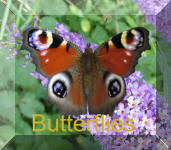Painted Lady (Vanessa cardui)
Identification
Large; wingspan, 65-70 mm.
Both sexes are predominantly orange-brown with black and white patterning. On their upper surfaces the inner (basal) half of the forewings have a number of black angular blotches whilst the tips are black with a series of white spots and blotches. The hind wings have a series of rather obscure dark markings on their inner half and the outer half is patterned with a series of three concentric black markings, the innermost being a series of spots. Both sets of wings have white outer margins interrupted with black markings. The underside of the forewings has a complex pattern resembling a subdued version of the upper surface although the orange-brown of the latter are replaced by a pink colour. The underside of the hind wings is extremely complex with white, brown and grey pattern elements together with a series of dark eyes towards the margin of the wings. The patterning is such that it is almost impossible to detect the butterfly when it is at rest with wings closed on bare earth.
IMAGES CORTESY OF STEVE SHROUD (C)




IMAGE (C) COLIN DUKE 2006 ALL RIGHTS RESERVED


(C) WARREN PHOTOGRAPHY

Behaviour and life history
The Painted Lady is a migrant species which regularly appears in this country but often in widely fluctuating numbers. The butterflies fly across from North Africa but cant breed in this country because they are unable to survive our winters. They are strong fliers and many seen in the City are migrants making their way northwards. Those that stay here seek out sunny sheltered spots where the males establish territories which are rigorously defended.
Where to look for it
The butterfly can turn up almost anywhere in the city where it is both sheltered and sunny and is a common visitor to gardens and parks. It is particularly attracted to the Butterfly-bush, Buddleja davidii, in late Summer. During migration it can sometimes be seen in large numbers .
Distribution and status
Widespread t. In good migratory years it can be very common but, on the other hand, it can be a rarity in poor years.
Similar species
A combination of its size and orange brown colour should make this butterfly unmistakeable. It is arguably the fastest flier of any of our local butterflies, which is also a good aid to its identification.

